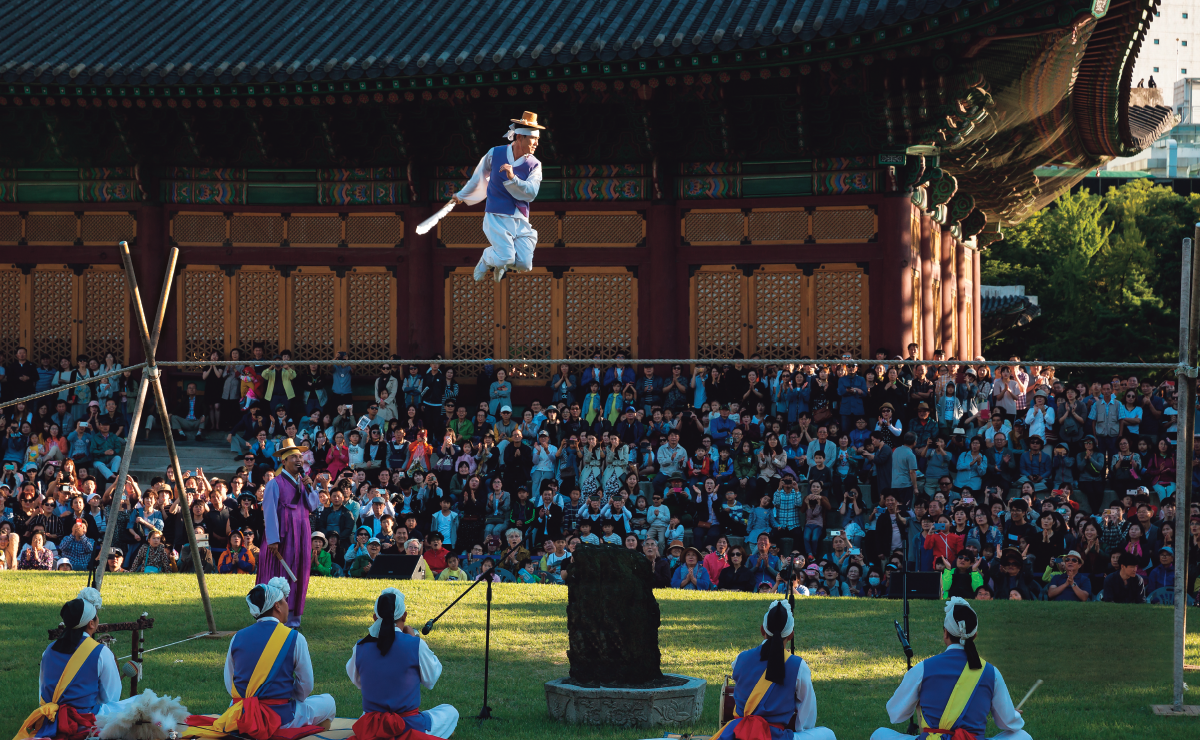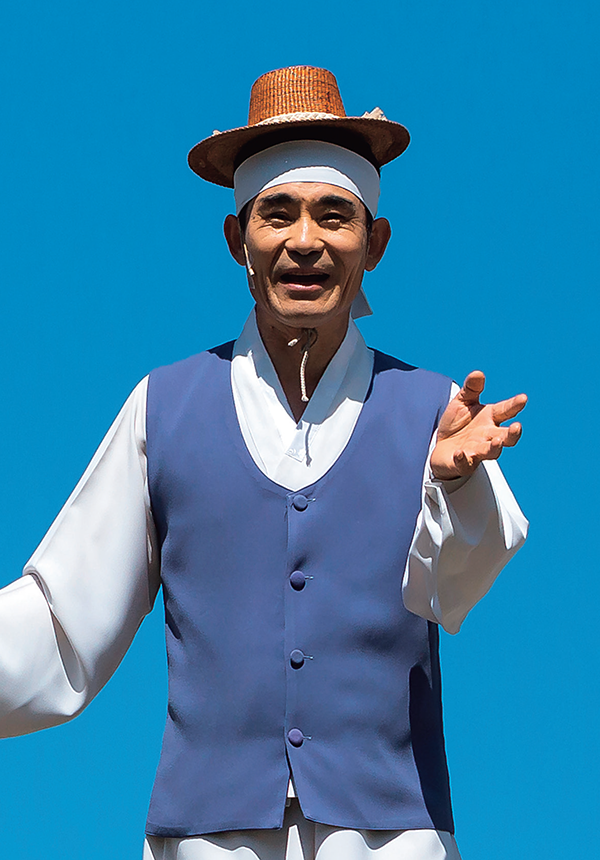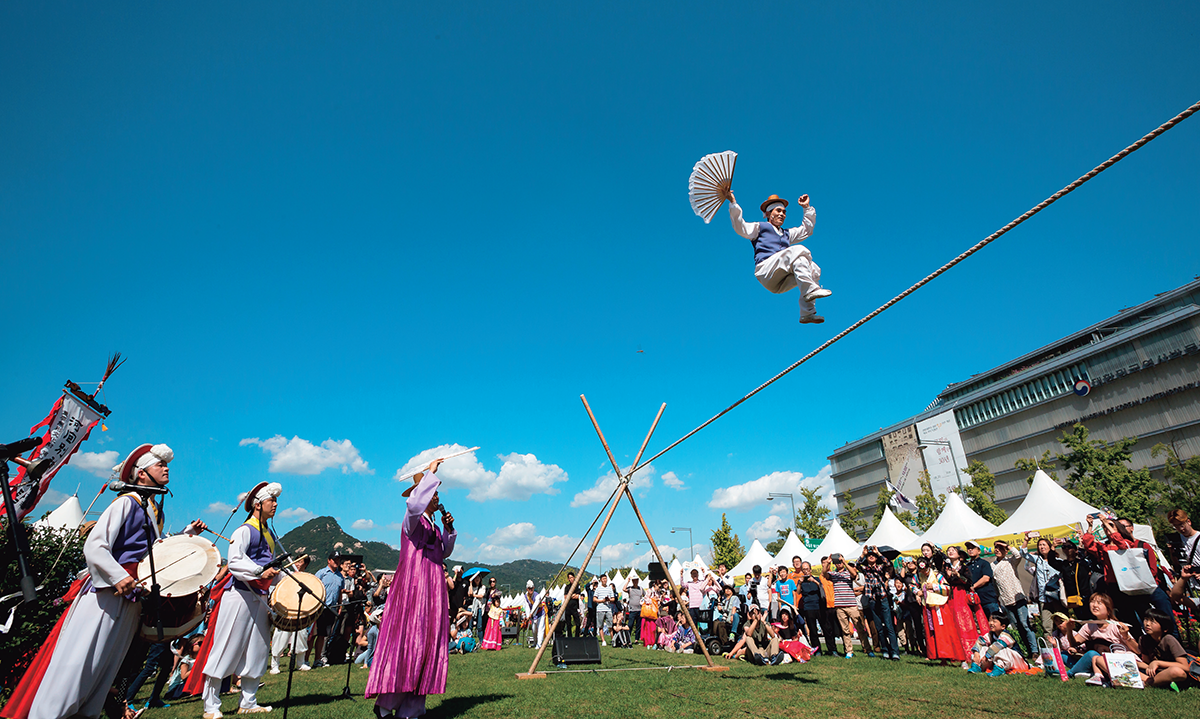With a small folding fan in his hand as the only prop for balance, Kwon Won-tae jumps, runs and talks on a nylon rope as thin as 3 cm, entertaining the spectators with his acrobatic feats and jokes. He considers traditional Korean tightrope walking to be not just a circus stunt but a performing art that involves interaction with the audience.

During a performance at Deoksu Palace in Seoul in late September, the master tightrope walker Kwon Won-tae presents geojung dolgi, the skill of jumping on the rope, turning 180 degrees in the air, and coming down again and sitting on the rope.
Coaxing him into talking about his art wasn’t easy. The tightrope walker of 40 years seemed to find some of my questions irrelevant, brushing them off and offering obscure answers with a rising tone at the end. Trying to speak the same language as the fastidious talker was itself like walking a tightrope.
“Imagine you’re climbing an icy hill. You’d be extremely cautious not to slip and tumble down the slippery slope, wouldn’t you? That’s why tightrope walkers used to be called eoreumsani [“icy hill climber”],” Kwon Won-tae said.
Like Icy Hill Climbing
Despite the precariousness evoked by the word, Kwon strides and swaggers on the eight- to nine-meter rope suspended three meters above the ground. He walks and runs on the rope, sometimes straddling it, soaring up to turn in the air before sitting down on the rope again. The rope is the tightrope walker’s stage, and throughout his performance, using no protective device whatsoever, he thrills the audience with dazzling feats.
“I perform for 30 or 40 minutes at a time. Traditional Korean tightrope walking is not suited for a long show lasting over an hour because a single performer has to engage the audience with banter and jokes as well. So, I’d say this is about the right amount of time,” Kwon said.
Tightrope walking, or jultagi, was part of Namsadang Nori, a popular folk show presented by all-male troupes of itinerant entertainers in pre-modern Korea. Nowadays, however, it is often performed separately at local festivals throughout the country. While circus performances of other countries focus on the visual spectacle of acrobatic feats on high wires, the Namsadang performer is a jester, combining tightrope techniques with humorous story-telling. This feature comes from the fact that the Korean version began as a small-scale performance providing diversion for common people leading hard-working lives, who had few sources of entertainment.
“Basically, I use the tightrope techniques and jokes as they have been handed down from the past, but I vary the act according to the locality, current social issues and audience responses,” Kwon said. “The number of techniques? That’s not important because you can always improvise on the spot.”
The Stage
A thin rope in the air is Kwon’s whole stage and the sole challenge he needs to conquer. A series of questions occurred to me. What kind of rope does he use? How is it different from the wires used in a circus? How did it feel to walk on the 50-meter rope when he covered the length in the record time of 19.33 seconds at the tightrope world records event held in 2004 in Tampa Bay, Florida? And what about the one-kilometer rope hung across the Han River in 2007, which he covered in 17 minutes and 6 seconds, competing with famous tightrope walkers from all over the world?
“Those events were held on metal wires, which are strong, taut and steady,” Kwon said. “A typical wire is about three centimeters thick with a tensile strength of 35 tons, which means it won’t break until the maximum load of 35 tons is applied. Performers take advantage of that strength. On the contrary, the Korean version is a soft nylon rope, which is unique in that it is flexible and bouncy. It is harder for the performer to maintain balance. The feeling of walking on a metal wire and on a nylon rope can be compared respectively to jumping on hard ground and on sand so soft that your feet sink into it.”
Not all the nylon ropes have the same tension and so the performer chooses the right level according to his preference. Asked if he sometimes used ropes with different tensions, Kwon furrowed his brows and rubbed his face with his hands. “The rope is a delicate thing,” he said finally. “There’s human life on the line. So, we’re cautious about changing ropes.”
Since Age Nine

A tightrope walker of over 40 years, Kwon says, “Traditional Korean tightrope walking is not just an acrobatic feat but a performing art that involves interaction with the audience with banter and jokes.”
I watched a video clip of his performance again. This time, I started to take notice not only of the performer’s movements but of the curves d by the shaking rope. Such was the movement of a man freed from the ground, and of a rope supporting his weight. Walking on the rope, he would unfold his fan and draw small curves in the air. The spectators might look at the fan as an item adding grace to his movements, but Kwon used it to maintain his balance by controlling wind resistance. Moving in the air with the single rope as his only foothold, the performer must overcome the wind with the fan as his only tool.
“Try and wave a fan to blow the wind, and you’ll feel the weight. You use the weight to control your balance. But that’s not all. If you hold your fan against a strong wind, it’ll act like a parachute,” he said. “How to keep balance — it’s not something you can explain with words.”
What would be the most difficult tightrope skill? What is the technique that presents the greatest challenge for any performer? Pondering these questions, he rubbed his face with both hands again.
“Training for tightrope walking is like growing up. As your body grows and the brain matures, your skills also improve without your knowing,” he answered. “You can’t just simply say that you’ve gone beyond a certain level, or that you’ve mastered a certain skill. Rather, your skills are gradually perfected and stabilized over time as you continue to perform. That’s how it works.”
As the questions and answers continued, Kwon’s art seemed less like a physical stunt, but rather something that reflected his life and mind. His parents, who were itinerant performers themselves, had him join the troupe when he was nine years old. He simply accepted the path in life laid out for him. Since childhood, his life has been inseparable from his art, and as he grew up as a person, he also matured as a performer. His life was one long learning process in which living and practicing was one and the same.
How does he feel when he recalls a lifetime spent on the tightrope? Could the memory be compartmentalized based on a time scale? No sooner had the questions been uttered than Kwon showed resistance to the idea that any ability could be measured by numbers.
“If I have to speak in those terms… Well, I would say that I was full of spirit in about the tenth year of training. Fearless, but with no style at all. I was busy following the repetitive training regimen,” he recalled. “When about 20 years had passed, I was able to find my own style and adjust my performance to my physical condition. After that, it was natural to get on the rope and decide on the spot which techniques I would present depending on my condition that day. Although I have 40 years of experience, my skills aren’t perfect yet. Even now, when the weather is bad, both the rope and my body feel heavy. There’s nothing I can do about that. In this sense, tightrope walking seems like a kind of extreme sport with no predetermined routine, flowing dynamically to cope with changing conditions.”
Kwon, who had been rather reserved in his responses, became impassioned when it came to the matter of height. The question was quite simple; it was intended to confirm the height of the rope used in his performance — three meters.
“It doesn’t matter how high the rope is installed. There’s a tremendous difference between a three-meter-high structure and a three-meter-high tightrope. The higher the rope is placed, the greater the risk and the sensation of fear. There’s no need to take a risk by raising it higher,” he said, raising his voice. “The Korean tradition is not a hire-wire stunt performed over a precipitous valley, but more like little tricks played on the rope, the performer making eye contact and conversing with the spectators.”
One doesn’t forget how to use chopsticks after a few days of not using them, and the same is true of the rope for tightrope performers, he explained. Nowadays, he usually performs without rehearsing in case he injures himself while practicing. He has suffered accidents from time to time, but he tries not to dwell on them because fear comes in different forms and degrees every time he stands on the rope. In the end, rising above that fear is a major part of his art. It must take a lot of mind training, I asked, but his reply was an unexpected one: “I don’t give it too much thought. I just tell myself, ‘This is my job, it involves danger,’ and so I’ll be cautious. And I try to be mindful of things around me. I don’t kill living creatures, especially winged animals, which I don’t harm or eat at all. For I’m also an aerial being.”
“Walking on the tightrope of life, you have to walk straight not to go astray,
maintaining your balance even when the wind makes you sway.”

Kwon performs on the lawn in front of the National Museum of Korean Contemporary History in Gwanghwamun, central Seoul. The fan in his hand is the only tool he uses to control wind resistance and maintain balance on the rope.
Life is a Tightrope
As fear comes and goes as it pleases, does he mean that his 40 years of experience is not sufficient to control it? In the face of this uncontrollable feeling, he just keeps a distance, taking somewhat symbolic measures to protect himself from misfortune. However, he does not allow any ambiguity or incompleteness in what is controllable.
“Of course, I install the rope myself. Erecting the poles, I always make sure that the ground is hard enough to sustain the load. I figure out the right amount of tension, when tying the ends of the rope to the poles on either side. If the rope is not tied properly, say, if it is too stiff and taut, the impact delivered to my body is enormous. I’m the only one who knows the tension that suits me, so I adjust the rope with my own hands,” he said.
A performer who considers the physics of load distribution. Sure enough, Kwon said he would have worked in engineering if he could have chosen another occupation. He especially liked handling machinery and could do simple repairs using parts of his own making; his life might have been more prosperous had he worked in that field. But asked if this alternative life was an unfulfilled dream, he brusquely answered that he’d never dreamed of it.
“This is a wonderful job if you don’t have to worry about making a living,” he said. “I’ve traveled overseas presenting my art, and have been respectfully called ‘Master Kwon.’ I also have my name inscribed in the ‘Guinness Book of World Records’ for performing geojung dolgi [jumping up from the sitting position and turning 180 degrees in the air before sitting on the rope again] 12 times in 30 seconds. Isn’t this enough to make a happy life?”
That’s not all. He was awarded the title of “Master” in Namsadang Nori, which is an Important Intangible Cultural Property of Korea, and on the UNESCO Representative List of the Intangible Cultural Heritage of Humanity.
For Kwon, life is a tightrope (jul): “What do you hold on to when you are born into the world? Yes, the umbilical cord (taetjul). A newborn baby starts life wrapped in swaddling tied with s (jul). What else? Sometimes you have to pull s (yeon-jul) to solve problems. Walking on the tightrope of life, you have to walk straight not to go astray, maintaining your balance even when the wind makes you sway. And where do you finally go at the end? You will be wrapped in hemp threads (sam-jul) and burned to ashes. Life starts and ends with all sorts of ropes.”
Finally he smiled, asking what life would be like without ropes. Where is he standing now on his tightrope of life? How nimbly and joyfully has he been walking and jumping on the rope? Fodder for thought offered by the tightrope walker.